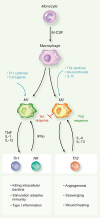Immunology in the clinic review series; focus on cancer: tumour-associated macrophages: undisputed stars of the inflammatory tumour microenvironment
- PMID: 22235995
- PMCID: PMC3278685
- DOI: 10.1111/j.1365-2249.2011.04515.x
Immunology in the clinic review series; focus on cancer: tumour-associated macrophages: undisputed stars of the inflammatory tumour microenvironment
Abstract
Mononuclear phagocytes are cells of the innate immunity that defend the host against harmful pathogens and heal tissues after injury. Contrary to expectations, in malignancies, tumour-associated macrophages (TAM) promote disease progression by supporting cancer cell survival, proliferation and invasion. TAM and related myeloid cells [Tie2(+) monocytes and myeloid-derived suppressor cells (MDSC)] also promote tumour angiogenesis and suppress adaptive immune responses. These divergent biological activities are mediated by macrophages/myeloid cells with distinct functional polarization, which are ultimately dictated by microenvironmental cues. Clinical and experimental evidence has shown that cancer tissues with high infiltration of TAM are associated with poor patient prognosis and resistance to therapies. Targeting of macrophages in tumours is considered a promising therapeutic strategy: depletion of TAM or their 're-education' as anti-tumour effectors is under clinical investigation and will hopefully contribute to the success of conventional anti-cancer treatments.
© 2012 The Authors. Clinical and Experimental Immunology © 2012 British Society for Immunology.
Figures


Similar articles
-
Tumor promoting role of anti-tumor macrophages in tumor microenvironment.Cell Immunol. 2017 Jun;316:1-10. doi: 10.1016/j.cellimm.2017.04.005. Epub 2017 Apr 13. Cell Immunol. 2017. PMID: 28433198 Review.
-
Pro-Tumoral Inflammatory Myeloid Cells as Emerging Therapeutic Targets.Int J Mol Sci. 2016 Nov 23;17(11):1958. doi: 10.3390/ijms17111958. Int J Mol Sci. 2016. PMID: 27886105 Free PMC article. Review.
-
Lurbinectedin reduces tumour-associated macrophages and the inflammatory tumour microenvironment in preclinical models.Br J Cancer. 2017 Aug 22;117(5):628-638. doi: 10.1038/bjc.2017.205. Epub 2017 Jul 6. Br J Cancer. 2017. PMID: 28683469 Free PMC article.
-
Disruption of tumour-associated macrophage trafficking by the osteopontin-induced colony-stimulating factor-1 signalling sensitises hepatocellular carcinoma to anti-PD-L1 blockade.Gut. 2019 Sep;68(9):1653-1666. doi: 10.1136/gutjnl-2019-318419. Epub 2019 Mar 22. Gut. 2019. PMID: 30902885
-
Heparanase: From basic research to therapeutic applications in cancer and inflammation.Drug Resist Updat. 2016 Nov;29:54-75. doi: 10.1016/j.drup.2016.10.001. Epub 2016 Oct 6. Drug Resist Updat. 2016. PMID: 27912844 Free PMC article. Review.
Cited by
-
CD14-expressing cancer cells establish the inflammatory and proliferative tumor microenvironment in bladder cancer.Proc Natl Acad Sci U S A. 2015 Apr 14;112(15):4725-30. doi: 10.1073/pnas.1424795112. Epub 2015 Mar 30. Proc Natl Acad Sci U S A. 2015. PMID: 25825750 Free PMC article.
-
Macrophage depletion reduces postsurgical tumor recurrence and metastatic growth in a spontaneous murine model of melanoma.Oncotarget. 2015 Sep 8;6(26):22857-68. doi: 10.18632/oncotarget.3127. Oncotarget. 2015. PMID: 25762633 Free PMC article.
-
A nanoparticle-incorporated STING activator enhances antitumor immunity in PD-L1-insensitive models of triple-negative breast cancer.JCI Insight. 2018 Nov 15;3(22):e120638. doi: 10.1172/jci.insight.120638. JCI Insight. 2018. PMID: 30429378 Free PMC article.
-
The Trinity of Matrix Metalloproteinases, Inflammation, and Cancer: A Literature Review of Recent Updates.Antiinflamm Antiallergy Agents Med Chem. 2020;19(3):206-221. doi: 10.2174/1871523018666191023141807. Antiinflamm Antiallergy Agents Med Chem. 2020. PMID: 32178620 Free PMC article. Review.
-
Interaction of tumor-associated macrophages and cancer chemotherapy.Oncoimmunology. 2019 Apr 13;8(7):1596004. doi: 10.1080/2162402X.2019.1596004. eCollection 2019. Oncoimmunology. 2019. PMID: 31143517 Free PMC article. Review.
References
-
- Dunn GP, Old LJ, Schreiber RD. The three Es of cancer immunoediting. Annu Rev Immunol. 2004;22:329–60. - PubMed
-
- Mantovani A, Romero P, Palucka AK, Marincola FM. Tumour immunity: effector response to tumour and role of the microenvironment. Lancet. 2008;371:771–83. - PubMed
-
- Schreiber RD, Old LJ, Smyth MJ. Cancer immunoediting: integrating immunity's roles in cancer suppression and promotion. Science. 2011;331:1565–70. - PubMed
-
- Pages F, Berger A, Camus M, et al. Effector memory T cells, early metastasis, and survival in colorectal cancer. N Engl J Med. 2005;353:2654–66. - PubMed
-
- Laghi L, Bianchi P, Miranda E, et al. CD3+ cells at the invasive margin of deeply invading (pT3-T4) colorectal cancer and risk of post-surgical metastasis: a longitudinal study. Lancet Oncol. 2009;10:877–84. - PubMed
Publication types
MeSH terms
Substances
LinkOut - more resources
Full Text Sources
Other Literature Sources
Miscellaneous

